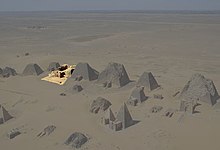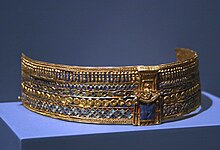Amanischacheto
| Name of Amanischacheto | ||||||||||||||||||
|---|---|---|---|---|---|---|---|---|---|---|---|---|---|---|---|---|---|---|
| Proper name |
in Meroitic hieroglyphics |
|||||||||||||||||

Amanischacheto , successor to the Amanirenas , ruled as the Nubian queen at the end of the first century BC. Chr.
It is through inscriptions in the temple of Amun at Kawa , through a granite stele that was found in Meroe (here it bears the title Kandake ), in inscriptions on a palace at Wad ban Naqa , a stele in Qasr Ibrim , another stele from Naqa and through their pyramid Beg N6 known in Meroe . She was the daughter of a certain Ar ... tchawit and perhaps a consort of Teriteqas , although the latter cannot be proven.
Amanischacheto is particularly known for a treasure trove of exquisite pieces of jewelry that was found in her pyramid in 1834 and is now in Berlin and Munich . Your pyramid, which was still well preserved at the time, was almost completely destroyed during the 'excavations' by the Italian doctor Giuseppe Ferlini . In 1821 her pyramid was drawn by Frédéric Cailliaud before it was destroyed . At that time it was about 28 meters high with 64 steps, only part of the top was missing. Her treasure contained 62 signet rings, 57 of them made of gold. The images on the seal face represent the so-called divine birth. According to Giuseppe Ferlini, the treasure was found in a small chamber in the pyramid. This seems very unusual as there are never any chambers in the Meroitic pyramids. Research suggests that the 'chamber' may have been a tomb robber shaft in which the robbers left part of their looted property.
During her reign, Nubia experienced a particular boom, as indicated by her extensive building activities in Kawa, Wad ban Naqa and the treasure. Even its stele from Meroe, although hardly legible, seems to report on construction work. The dating of this queen has recently been debated in research, as a stele of the queen was found in a temple in Naqa that was built by Natakamani . Natakamani has been classified according to Amanischacheto, but if the queen seems to have donated a stele in an already standing temple, the chronology must be exactly the opposite. The older stele could, however, have been moved to the younger temple later. This thesis would again support the traditional chronology. This case is also further evidence of the great uncertainties in the Nubian chronology.
See also
literature
- Angelika Lohwasser : The pyramid of Queen Amanishakheto . In: Sokar. No. 3, 2001, pp. 43-45.
- László Török in Tormod Eide u. a .: Fontes historiae nubiorum: textual sources for the history of the middle Nile region between the eighth century BC and the sixth century AD. Vol. 2. From the mid fifth to the first century BC (= Fontes historiae Nubiorum. Volume 2). University of Bergen, Bergen 1996, ISBN 82-91626-01-4 , pp. 723-725.
- Steffen Wenig : Amanishakhetē. In: Wolfgang Helck (Hrsg.): Lexikon der Ägyptologie (LÄ). Volume I, Harrassowitz, Wiesbaden 1975, ISBN 3-447-01670-1 , Sp. 170-171.
- Dietrich Wildung : The Gold of Meroë (PDF; 7.0 MB). In: Kemet . Issue 1/2011. Kemet Verlag, Berlin 2011, ISSN 0943-5972 , pp. 45-47.
Web links
- Stele found in Naqa ( Memento from February 28, 2008 in the Internet Archive )
- Chicago Oriental Institute Archives: Photo of the destroyed pyramid
- Representation in their pyramid chapel (Lepsius)
- Depiction on the pylon of her pyramid temple (Lepsius)
| personal data | |
|---|---|
| SURNAME | Amanischacheto |
| BRIEF DESCRIPTION | nubian queen |
| DATE OF BIRTH | 1st century BC Chr. |
| DATE OF DEATH | 1st century BC Chr. |

